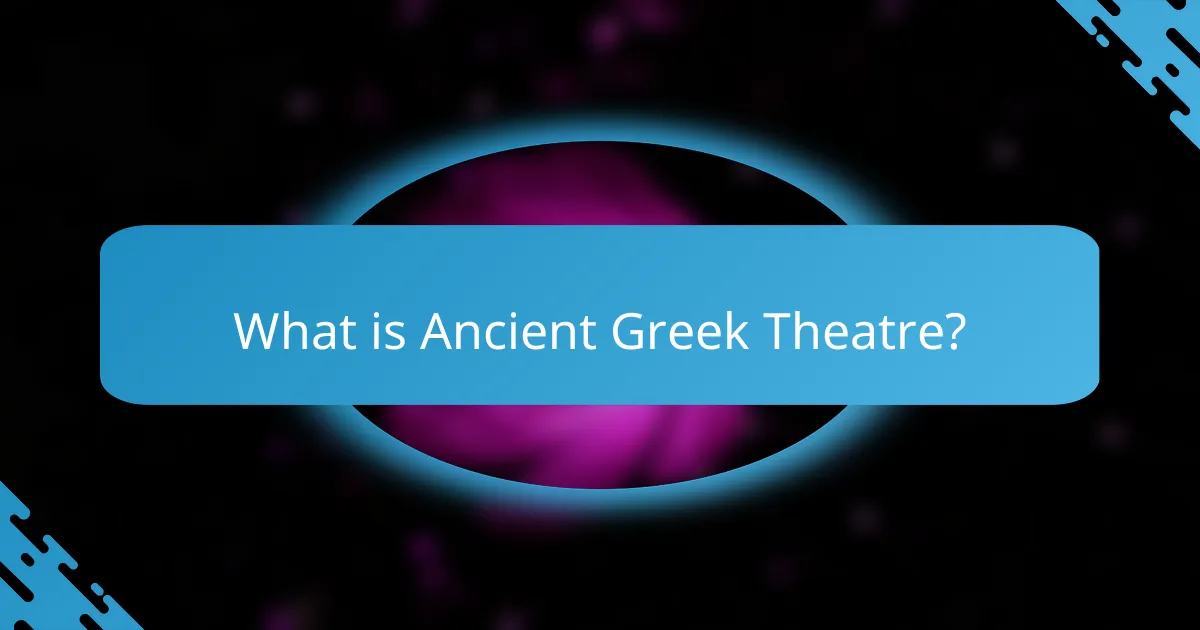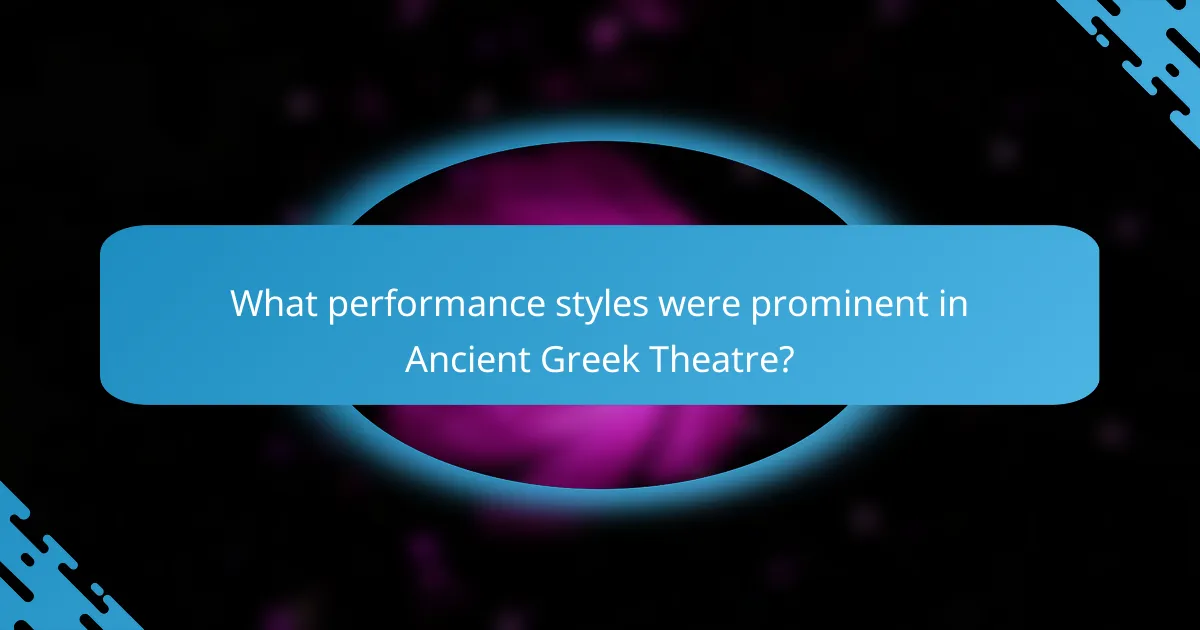Ancient Greek Theatre is a significant form of performance art that emerged in ancient Greece around the 6th century BCE, characterized by dramatic storytelling rooted in mythology and historical events. This theatrical tradition played a crucial role in Greek culture, serving both entertainment and religious functions, particularly during major festivals like the Dionysia. Key playwrights such as Aeschylus, Sophocles, and Euripides contributed to the evolution of the genre, introducing innovations that shaped Western drama. The primary performance styles included tragedy, which dealt with serious themes and noble struggles, and comedy, exemplified by Aristophanes, which utilized humor and satire to critique society. The use of masks and elaborate costumes was prevalent, enhancing the overall theatrical experience.

What is Ancient Greek Theatre?
Ancient Greek Theatre is a form of performance art that originated in ancient Greece around the 6th century BCE. It is characterized by its use of dramatic storytelling, often based on mythology and historical events. The theatre was an essential part of Greek culture, serving both entertainment and religious purposes. Major festivals, such as the Dionysia, showcased plays by renowned playwrights like Aeschylus, Sophocles, and Euripides. These works were performed in large amphitheaters, which enhanced acoustics and audience engagement. The themes often explored moral dilemmas, human nature, and the relationship between gods and mortals. Ancient Greek Theatre laid the foundation for modern drama and theatrical practices.
How did Ancient Greek Theatre originate?
Ancient Greek Theatre originated from religious festivals honoring Dionysus, the god of wine and fertility. These festivals included performances of hymns and dances known as dithyrambs. The first recorded drama took place in Athens around the 6th century BCE. Thespis, often considered the first actor, introduced the concept of a solo performer. This innovation allowed for dialogue and storytelling, transforming the performance format. The theatre evolved with playwrights like Aeschylus, Sophocles, and Euripides contributing significant works. The structure of theatres became more elaborate, featuring large, open-air venues. By the 5th century BCE, theatre became a central aspect of Athenian culture, reflecting societal values and beliefs.
What cultural influences shaped the early development of Ancient Greek Theatre?
Religious festivals significantly shaped the early development of Ancient Greek Theatre. These festivals honored gods, particularly Dionysus, the god of wine and fertility. The City Dionysia festival featured dramatic competitions, which promoted theatrical performances. Additionally, the influence of mythology provided rich narratives for playwrights. The cultural practice of storytelling also contributed to the evolution of theatrical forms. Furthermore, the interaction with neighboring cultures, such as the Egyptians and Phoenicians, introduced new performance styles and techniques. This blend of religious, mythological, and cultural elements laid the foundation for the structure and themes of Ancient Greek Theatre.
What role did religion play in the origins of Ancient Greek Theatre?
Religion was fundamental to the origins of Ancient Greek Theatre. It served as a catalyst for the development of theatrical performances. The earliest forms of theatre emerged from religious festivals dedicated to Dionysus, the god of wine and fertility. These festivals included rituals, hymns, and dances that eventually evolved into dramatic presentations. The City Dionysia, held in Athens, was a key festival that featured competitions among playwrights. This festival emphasized the connection between worship and performance, showcasing tragedies and comedies that often explored religious themes. The integration of religious elements in theatre helped shape the narrative and moral frameworks of the plays. Thus, religion not only inspired the creation of theatre but also influenced its thematic content and cultural significance.
What are the key components of Ancient Greek Theatre?
The key components of Ancient Greek Theatre include the orchestra, skene, and audience. The orchestra is a circular space where the chorus performed. The skene served as a backdrop for the action and housed props. The audience sat in a semi-circular arrangement, allowing for optimal viewing. The theatre was designed to enhance acoustics for clear sound delivery. Greek tragedies and comedies were the primary genres performed. Notable playwrights included Aeschylus, Sophocles, and Euripides. These components contributed to the unique cultural significance of theatre in ancient Greece.
What architectural features are characteristic of Ancient Greek theatres?
Ancient Greek theatres are characterized by several distinct architectural features. The most prominent feature is the semicircular seating arrangement known as the theatron. This design allowed for optimal acoustics and visibility for the audience. Another key element is the orchestra, a circular space where the chorus performed. The skene, a structure at the back of the stage, served as a backdrop and changing area for actors. Additionally, the parodos are the entrance pathways for the chorus and audience. These theatres often incorporated natural landscapes into their design, enhancing the overall experience. The use of stone and marble in construction provided durability and aesthetic appeal. Historical examples include the Theatre of Epidaurus, renowned for its exceptional acoustics and preservation.
How did the layout of the theatre affect performances?
The layout of the theatre significantly affected performances by enhancing acoustics and visibility. The design featured a semicircular arrangement, allowing sound to travel efficiently to the audience. This layout ensured that even the smallest gestures and vocal nuances were perceivable from the back rows. Additionally, the elevated stage allowed actors to be seen clearly from all angles. The use of natural slopes facilitated better sightlines, minimizing obstruction. Historical accounts indicate that this design maximized audience engagement during performances. The combination of these elements created an immersive experience, crucial for the storytelling in Ancient Greek theatre.

Who were the key playwrights of Ancient Greek Theatre?
The key playwrights of Ancient Greek Theatre include Aeschylus, Sophocles, and Euripides. Aeschylus is often referred to as the father of tragedy. He introduced the second actor, which allowed for dialogue and complex narratives. Sophocles is known for his innovations in dramatic structure. He added a third actor and introduced painted scenery. Euripides is recognized for his focus on character psychology and emotional depth. His works often challenged traditional values and societal norms. These playwrights significantly shaped the development of Western drama. Their contributions are still studied and performed today.
What contributions did Aeschylus make to Ancient Greek Theatre?
Aeschylus significantly contributed to Ancient Greek Theatre by introducing the second actor, which allowed for dialogue between characters. This innovation expanded the complexity of storytelling. He is also credited with developing the use of scenery and props in performances. Aeschylus wrote around 90 plays, of which seven survive today, showcasing his impact on the genre. His works often explored themes of justice and divine intervention. Aeschylus is known for the trilogy format, as seen in “The Oresteia.” His contributions laid the groundwork for future playwrights like Sophocles and Euripides.
How did Aeschylus influence the structure of Greek tragedy?
Aeschylus significantly influenced the structure of Greek tragedy by introducing a second actor. This innovation allowed for more complex dialogue and interactions. Prior to Aeschylus, performances typically featured a single actor interacting with a chorus. His introduction of multiple characters deepened the narrative and character development. Aeschylus is also credited with expanding the role of the chorus. He increased its size and integrated it more closely into the action of the play. Additionally, he emphasized themes of fate and divine justice, shaping the moral framework of tragedies. His works, such as “The Oresteia,” exemplify these structural advancements. Aeschylus’s contributions laid the groundwork for later playwrights like Sophocles and Euripides.
What are some notable works by Aeschylus?
Aeschylus is known for several notable works in ancient Greek theatre. His most famous plays include “Agamemnon,” “The Libation Bearers,” and “The Eumenides.” These three plays form the “Oresteia” trilogy, which explores themes of justice and revenge. Another significant work is “Prometheus Bound,” which addresses themes of suffering and defiance. Aeschylus is credited with introducing the second actor, enhancing dramatic dialogue. His contributions significantly shaped the structure of Greek tragedy. The historical impact of his plays continues to influence modern theatre.
What impact did Sophocles have on Ancient Greek Theatre?
Sophocles significantly transformed Ancient Greek Theatre by introducing innovations that enhanced dramatic storytelling. He is credited with adding a third actor to performances, which allowed for more complex interactions and character development. His introduction of painted scenery provided a more vivid backdrop, enriching the visual experience for audiences. Sophocles also emphasized character depth, moving away from the one-dimensional portrayals common in earlier works. His plays often explored profound themes of fate, morality, and the human condition. Notably, his work “Oedipus Rex” is a prime example of his mastery in tragic structure and character arcs. Sophocles’ contributions laid the groundwork for the evolution of Greek tragedy and influenced playwrights for centuries. His innovations remain foundational in the study of drama and theatre.
How did Sophocles innovate character development in plays?
Sophocles innovated character development in plays by introducing complex characters with distinct personalities. He moved beyond the one-dimensional characters typical of earlier playwrights. His characters displayed a range of emotions and moral dilemmas. This depth allowed audiences to connect with them on a personal level. Sophocles also employed the use of dialogue to reveal character motivations. His characters often faced significant internal conflicts, enhancing dramatic tension. For instance, in “Oedipus Rex,” Oedipus grapples with fate and his own actions. This approach set a new standard for character portrayal in theater.
What themes are prevalent in Sophocles’ works?
Sophocles’ works prominently explore themes of fate, free will, and the human condition. His plays often illustrate the struggle between individual desires and predetermined destiny. Characters frequently face moral dilemmas that reveal their inner conflicts. The theme of tragic heroism is central, showcasing protagonists with noble qualities who fall from grace. Sophocles also emphasizes the consequences of hubris, highlighting the dangers of excessive pride. Additionally, themes of loyalty, family, and the quest for truth are prevalent throughout his narratives. His use of dramatic irony further enhances these themes, engaging the audience in the characters’ fates.
What legacy did Euripides leave in Ancient Greek Theatre?
Euripides significantly influenced Ancient Greek Theatre through his innovative character development and complex plots. He introduced strong female characters, such as Medea and Electra, which challenged traditional gender roles. Euripides often portrayed the psychological motivations of his characters, adding depth to their actions. His plays frequently questioned societal norms and moral values, prompting audiences to think critically. He is known for his use of prologues and dramatic irony, enhancing narrative tension. Euripides’ works, including “The Bacchae” and “Hippolytus,” are still studied for their thematic richness. His legacy paved the way for modern drama by emphasizing realism and emotional depth.
How did Euripides challenge societal norms through his plays?
Euripides challenged societal norms through his plays by presenting complex characters and controversial themes. He often depicted women as strong, independent figures, contrasting with traditional gender roles. In works like “Medea,” he explored female agency and vengeance. Euripides also questioned the morality of the gods, presenting them as flawed and capricious. His characters frequently faced moral dilemmas that reflected the complexities of human nature. By addressing taboo subjects such as war, suffering, and social injustice, he provoked audiences to reconsider their beliefs. His innovative narrative techniques and emotional depth set him apart from his contemporaries.
What are some significant plays written by Euripides?
Euripides wrote several significant plays that are still studied today. Notable works include “Medea,” which explores themes of revenge and betrayal. Another important play is “The Bacchae,” focusing on the conflict between reason and primal instinct. “Hippolytus” examines the consequences of desire and honor. “Electra” deals with themes of vengeance and family loyalty. Lastly, “The Women of Troy” addresses the aftermath of war and its impact on women. These plays are key examples of Euripides’ exploration of complex human emotions and societal issues.

What performance styles were prominent in Ancient Greek Theatre?
Prominent performance styles in Ancient Greek Theatre included tragedy and comedy. Tragedy focused on serious themes and often depicted the struggles of noble characters. Notable playwrights like Aeschylus, Sophocles, and Euripides shaped this genre. Comedy, on the other hand, was characterized by humor and satire. Aristophanes was a key figure in this style, using comedic elements to critique society. These two styles were performed during festivals, such as the Dionysia, which celebrated the god Dionysus. The use of masks and elaborate costumes was common in both styles, enhancing the theatrical experience.
What types of performances were common in Ancient Greek Theatre?
Common performances in Ancient Greek Theatre included tragedies, comedies, and satyr plays. Tragedies focused on serious themes and often involved a moral lesson. Notable playwrights like Aeschylus, Sophocles, and Euripides contributed to this genre. Comedies, exemplified by playwrights such as Aristophanes, utilized humor and satire to critique society. Satyr plays were short, comedic performances that featured choruses of satyrs. These performances were integral to festivals like Dionysia, celebrating the god Dionysus. The combination of these genres showcased the diversity of storytelling in Ancient Greek culture.
How did tragedy differ from comedy in performance style?
Tragedy differed from comedy in performance style primarily through its serious tone and emotional depth. Tragedies often featured elevated language and formal structure. They focused on themes of fate, suffering, and moral dilemmas. The performance style emphasized dramatic expression and intense character portrayals. In contrast, comedies utilized humor and satire. Comedic performances often included exaggerated characters and situations. They aimed to entertain and provoke laughter, often addressing social issues in a light-hearted manner. Historical records show that playwrights like Aeschylus and Sophocles were known for tragedy, while Aristophanes was a notable comic playwright. This distinction in style influenced the audience’s emotional engagement and response.
What role did improvisation play in Ancient Greek performances?
Improvisation played a significant role in Ancient Greek performances. It allowed actors to adapt their performances spontaneously. This flexibility was essential in comedic plays, where humor often relied on current events and audience reactions. Actors used improvisation to enhance character interactions and develop plots dynamically. The practice encouraged creativity and engagement with the audience. Historical records indicate that improvisation was a common technique in ancient festivals. These festivals included dramatic competitions where improvisation could influence the outcome. Overall, improvisation contributed to the vibrancy and immediacy of Ancient Greek theatre.
How did actors and performers contribute to Ancient Greek Theatre?
Actors and performers were essential to Ancient Greek Theatre. They brought characters to life through dialogue and physical expression. Their performances conveyed emotions and themes central to the plays. The introduction of the actor, or “hypokrites,” by Thespis around 534 BCE marked a significant development. This innovation allowed for interaction between the actor and the chorus. Performers used masks to portray different characters and emotions. They contributed to storytelling by interpreting playwrights’ works. The use of elaborate costumes enhanced the visual spectacle of the performances. Overall, actors and performers shaped the cultural and artistic landscape of Ancient Greece through their contributions.
What were the roles of actors in Ancient Greek plays?
Actors in Ancient Greek plays primarily served as performers who portrayed characters and conveyed the narrative. They were responsible for delivering lines, expressing emotions, and engaging the audience. In these performances, actors often played multiple roles, sometimes changing costumes or masks to represent different characters. The use of masks was essential, as it allowed a single actor to depict various personas.
Additionally, actors contributed to the overall spectacle of the play through movement and gestures. They worked closely with the chorus, which provided commentary and context to the story. The number of actors was limited, typically ranging from one to three, which emphasized their versatility.
This structure was a key aspect of Greek theatre, as it shaped the storytelling and performance dynamics. Historical records indicate that prominent playwrights like Aeschylus, Sophocles, and Euripides utilized these actors to enhance their dramatic works.
How did the use of masks influence performance styles?
The use of masks significantly influenced performance styles in Ancient Greek theatre. Masks allowed actors to portray multiple characters. They created exaggerated [censured] expressions that enhanced visibility from a distance. This helped convey emotions and character traits effectively. The use of masks also standardized performances. Actors could adopt a specific persona easily. Additionally, masks contributed to the mystical quality of performances. They allowed for transformation and anonymity, enhancing dramatic storytelling. Historical evidence shows that masks were integral to the theatrical experience in Ancient Greece.
What can we learn from Ancient Greek Theatre today?
Ancient Greek Theatre teaches us about the foundations of drama and storytelling. It emphasizes the importance of conflict and character development. The works of playwrights like Aeschylus, Sophocles, and Euripides highlight complex human emotions. Their tragedies explore themes of fate, morality, and the human condition. Greek theatre also showcases the significance of performance space and audience engagement. The use of masks and costumes illustrates the role of visual storytelling. Additionally, it reflects societal values and political commentary of its time. These elements continue to influence modern theatre and film.
How can contemporary theatre draw inspiration from Ancient Greek Theatre?
Contemporary theatre can draw inspiration from Ancient Greek Theatre through themes, structure, and performance techniques. Greek tragedies often explore universal themes such as fate, morality, and human suffering. These themes remain relevant and resonate with modern audiences.
The structure of Greek plays, including the use of prologues and choruses, can be adapted in contemporary works. This structure enhances narrative depth and audience engagement. Performance techniques, such as the use of masks and heightened emotion, can also be incorporated to create a powerful visual and emotional experience.
Moreover, the incorporation of Greek mythology and historical context can enrich contemporary narratives. By referencing these ancient stories, modern playwrights can provide layers of meaning. The influence of Greek theatre on dramatic conventions is evident in the works of playwrights like Tennessee Williams and Arthur Miller, who explore similar themes of tragedy and conflict.
In summary, contemporary theatre can effectively draw from Ancient Greek Theatre by adopting its themes, structure, and performance techniques to create compelling and relevant narratives.
What are some best practices for modern theatre inspired by Ancient Greek techniques?
Utilizing chorus as a narrative device enhances storytelling in modern theatre. This technique involves a group of performers commenting on the action, similar to Ancient Greek plays. Incorporating masks allows for exaggerated expressions, facilitating character portrayal and emotional depth. Emphasizing dialogue and rhetoric reflects the importance of language in Greek tragedies. Creating communal experiences through outdoor performances mirrors the original amphitheater settings. Implementing themes of fate and morality resonates with contemporary audiences, echoing Greek philosophical inquiries. Engaging in audience interaction fosters a connection reminiscent of ancient theatrical practices. Prioritizing visual spectacle through elaborate staging and costumes draws inspiration from Greek aesthetics.
Ancient Greek Theatre is a significant form of performance art that emerged in ancient Greece around the 6th century BCE, characterized by dramatic storytelling rooted in mythology and historical events. The article explores its origins linked to religious festivals, the influence of key playwrights such as Aeschylus, Sophocles, and Euripides, and the architectural features of theatres that enhanced performances. It also examines the prominent performance styles of tragedy and comedy, the role of actors, and the lasting legacy of Ancient Greek Theatre on modern drama. Key themes, structural innovations, and performance techniques are highlighted to illustrate their relevance in contemporary theatre practices.



